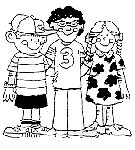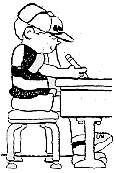The following information is mainly based on a seminar presented by Dr. Lollar, a Psychologist from Atlanta, at the Spina Bifida Association of America Conference, Memphis in 1990.
The majority of these children fall within the normal range of intelligence however, many will perform at a low average level, experiencing difficulties and poor performance abilities in one or more areas of learning. It is common for children to demonstrate uneven development (there may be a significant difference between verbal IQ and performance IQ). This unevenness in performance may be attributed to gaps in cognitive function (ability to learn) known as specific learning difficulties. These difficulties have implications for the children in all settings: home, childcare, kindergarten, pre-school and school. The difficulties often continue into adulthood.
- Poor eye-hand coordination (called perceptual motor)
- Comprehension (understanding what the senses take in)
- Attention deficit (paying attention)
- Hyperactivity (restless,fidgety behaviour)
- Memory
- Organization
- Sequencing (keeping ideas in order)
- Problem solving and decision making
- Young children need all their senses stimulated - seeing, hearing, smelling, tasting, touching and moving. Especially help the child with spina bifida with mobility impairment to experience moving in space: rolling, somersaulting and words for spatial relations, such as over/under, in/out, etc. Activities and games that use eye-hand skills are also important, such as "take-apart" toys, Lego, blocks, objects strung on cord or laces, etc. These activities will help with perceptual motor (eye-hand) skills.
- Many children with spina bifida have verbal skills beyond their years, but they may not understand or remember what they hear and say. They can be helped with these skills by discussing books or television shows after seeing/hearing them, acting out stories, developing memory games to associate things that need to be remembered, and by using calendars and maps to add a visual dimension to things that are usually just heard.
- Difficulty paying attention is common in children with spina bifida in school and at home. Schoolwork and homework may be more easily accomplished if the child has a quiet place, free from distractions, to work. Short assignments or chores, and frequent breaks can also help. The child may need regular reminders to stay on task.
- Hyperactivity in the child with spina bifida may be masked by the mobility difficulties, but restlessness and fidgety behaviour are common. In addition, these children may be impulsive, acting before they think. Regular exercise, "counting to ten" before acting, and building short breaks that involve some light exercise between tasks or chores can help children with this problem. Again, however, some children may require evaluation and medication by a neurologist for hyperactivity that seriously interferes with learning.
- Organising their things, and keeping things or ideas in order are frequently difficult for children with spina bifida. Young children should be encouraged to put things away in clearly labelled places. Try to reduce the number of things the child must keep track of (for example, take to school) to the necessary minimum. Encourage dot-to-dot and other similar activities in which a particular order is required. Reduce instructions to two or three steps (this is particularly important when the child must follow instructions for self-catheterisation or similar tasks). Help children schedule their daily activities and decide on the order of these activities, even writing them down to aid memory.
- To help children learn to make decisions, parents can give choices to even very young children - would you like milk or juice, do you want to wear the red shirt or the blue shirt. Next, children would learn that consequences go with their decisions. Help children think through situations, exploring the options, listing advantages and disadvantage, of each action, and then trying out the solution. Help them develop a "can do" attitude towards making decisions and figuring out solutions to problems.
In spite of these difficulties, most children with spina bifida are able to attend mainstream education, thanks to the commitment of parents, teachers, teacher aides and the resources of advisory teachers and visiting nursing services.
Active participation and social interaction in educational settings, clubs, youth groups, etc, is important as the disabled child like any other child wants and needs to be accepted as a friend.

